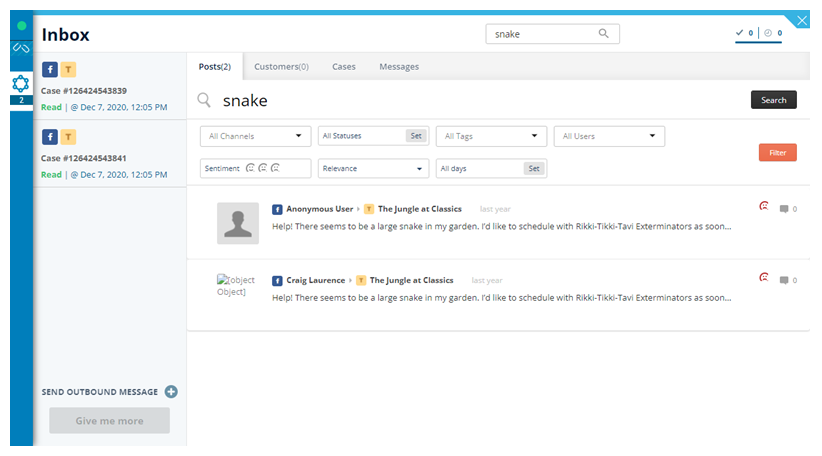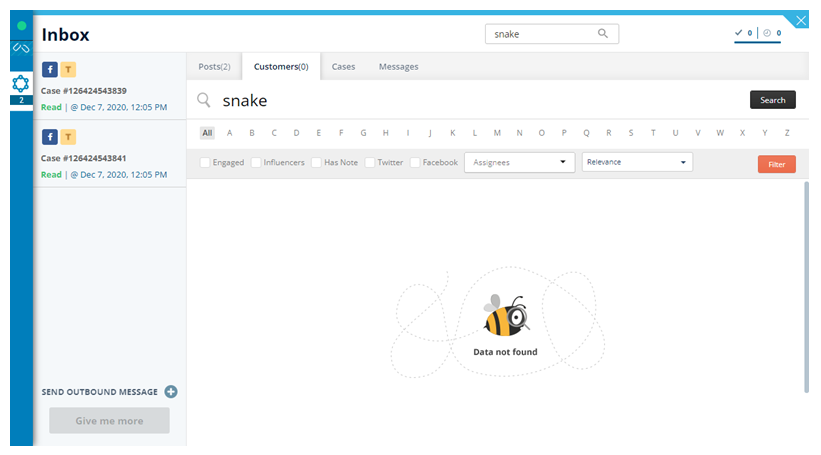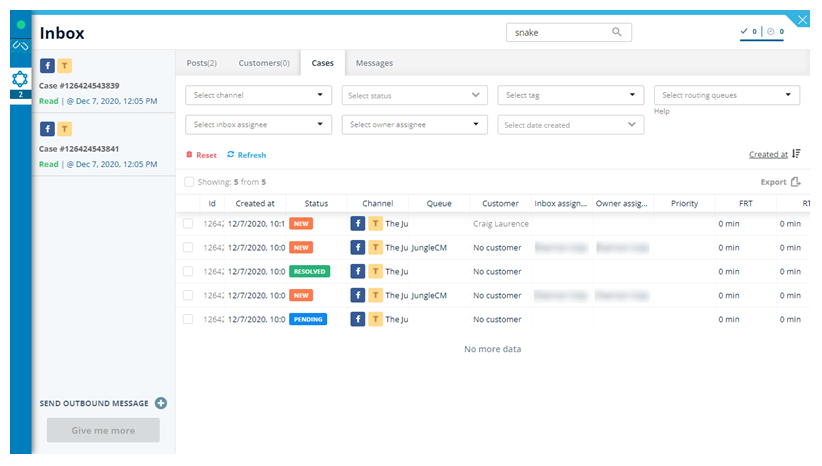You can use the Search field in the MAX digital channels inbox![]() Area where cases appear in the digital interaction workspace in an agent application to locate a specific customer, case
Area where cases appear in the digital interaction workspace in an agent application to locate a specific customer, case![]() An interaction with one contact about one topic that can consist of many inbound and outbound messages., post
An interaction with one contact about one topic that can consist of many inbound and outbound messages., post![]() A social media post that can result in multiple threads from various contacts., or message. You can narrow your search with filtering options such as tags or channels. For example, you can choose a channel to limit your search to cases in that channel.
A social media post that can result in multiple threads from various contacts., or message. You can narrow your search with filtering options such as tags or channels. For example, you can choose a channel to limit your search to cases in that channel.
Searching is an optional feature. Depending on how your administrator has set up the feature, you may be limited to a certain type of search. For example, you may be able to search for messages but not customers. If you don't see the Search field in your digital inbox, your administrator has disabled the search option.
Filtering Options to Narrow Your Search
You can narrow your search by using one or more of the filtering options on the tab you are searching. Not all filtering options are available for every type of search.
Search terms and filtering options combine. The more terms and options you provide, the fewer interactions will match your search. For example, lost banana will match a longer list of interactions than lost banana combined with filtering options that limit the channel![]() A way for contacts and agents to interact, such as voice, email, chat, social media, and so on. to Facebook and the status to Resolved.
A way for contacts and agents to interact, such as voice, email, chat, social media, and so on. to Facebook and the status to Resolved.
|
Filtering Option |
Details |
Available for |
|---|---|---|
| Agent | The agent who sent a message. | Messages |
| Assignees |
The MAX user a case
For example, Mowgli takes a new case from the queue. He is now the inbox assignee for the case. The case doesn't yet have an owner assignee. When Mowgli finishes his response, he closes the case's tab, ending the interaction. The case now shows Mowgli as the owner assignee. The case doesn't have an inbox assignee until the next day when Hathi opens the case and sends a message to update to the customer. Hathi is the inbox assignee, but Mowgli is still the owner assignee. When Hathi closes the case's tab, he becomes the owner assignee. |
Cases, Customers |
| Channel | The channel the interaction is associated with. Includes voice and digital channels. | Cases, Messages, Posts |
| Date Created, Days, Date | Indicates a date or range of dates. | Cases, Messages, Posts |
| Engaged | Select to identify contacts that are waiting for responses. | Customers |
| Select to find customers who have contacted your organization with Facebook. | Customers | |
| Has Note | Select to narrow your search to customers that have notes added to their customer cards. | Customers |
| Influencers | Select to limit your search to contacts that your organization has identified as are social media influencers |
Customers |
| Read Status | A set of statuses that indicate if the message has been read. | Messages |
| Relevance | A set of filtering options you can use to narrow your search. The options, shown in the next table, vary depending on the search type. | Customers, Posts |
| Resolution Time | The time when the case status was changed to Resolved. Use this option to sort the cases that match the filtering options. You can choose it by clicking the text next to the sorting icon. | Cases |
| Routing Queue |
Select the routing queue |
Cases |
| Sentiment | The sentiment applied to an interaction. | Messages, Posts |
| Status | The current status of the interaction. | Cases, Posts |
| Tag | A set of tags available for applying to cases, messages, or posts. The available tags vary. Each organization creates tags to meet its needs. | Cases, Messages, Posts |
| Select to find customers who have contacted your organization with Twitter. | Customers | |
| Users | Select a MAX user to show only posts currently assigned to that agent. | Posts |
Relevance Filtering Options
The options in this table are available in the Relevance drop-down list. You can find this list on the Customers tab and the Posts tab when searching in MAX. Not all options are available on both tabs.
|
Field |
Details |
|---|---|
| First Name | Select to search using the customer's first name. |
| Inbound Posts | Select to limit your search to posts made by customers to your organization |
| Newest | Select to show the newest posts first. |
| Oldest | Select to show the oldest posts first. |
| Outbound Posts | Select to limit your search to posts agents have made to customers. |
| Surname | Select to search using the customer's last name. |
Search Tips
|
To Do This |
Enter Your search like this |
|---|---|
| Search for an exact match |
Put a word or phrase inside quotation marks. For example: "lost banana" will match lost banana but not lost yellow banana. |
| Include all words from your search |
Put AND or a space between each word you want to include. For example: lost AND banana will match any interaction that contains both lost and banana. |
| Broaden your search |
Put OR between each word in your search. For example: lost OR banana will match any interaction that contains either lost or banana as well as any interaction that contains both terms. |
| Exclude words |
Put NOT or a minus sign to exclude words. For example: lost NOT banana will match any interaction that contains lost but not banana. Any interaction that also contains banana will not be a match. |
| Use multiple operators |
AND, OR, and NOT are operators. When using more than one operator, put parentheses around the words you want to group with each operator. For example: (lost AND banana) NOT monkey will match any interaction that includes lost and banana. It will exclude any interaction that also contains monkey. |
| Search for wildcards, unknown words, or partial words |
Put an asterisk in the word or phrase as a placeholder or wildcard. For example: ban* will match banana, banter, bannister, ban, and so on. |
| Use of special characters |
To include the following special characters and symbols in your search, place them in quotation marks: = & |> < { } [ ] ^ ~ ? : \ / For example: banana"/"plantain will match any interaction that includes banana/plantain. |
Search for Posts
-
In MAX, use the Search field in the digital inbox
 Area where cases appear in the digital interaction workspace in an agent application.
Area where cases appear in the digital interaction workspace in an agent application. -
Click the Posts tab.
-
Search and filter to find the posts
 A social media post that can result in multiple threads from various contacts. you want to see:
A social media post that can result in multiple threads from various contacts. you want to see:-
Enter a word or phrase in the text area next to the search icon at the top of the Posts tab. Click Search.
-
Select one or more filtering options to narrow your search. Click Filter to apply the selected filtering option.
-
- Continue adding or removing search terms and filtering options until you locate the post you need.
Search for Customers
-
In MAX, use the Search field in the digital inbox
 Area where cases appear in the digital interaction workspace in an agent application.
Area where cases appear in the digital interaction workspace in an agent application. -
Click the Customers tab.
-
Search and filter to find the customers you want to see:
-
Enter the customer's first, last, or full name in the text area next to the search icon at the top of the Customers tab. Click Search.
-
Click a letter of the alphabet to narrow the search to first or last names beginning with that letter and click Filter.
-
Select one or more filtering options to narrow your search. Click Filter to apply the selected filtering option.
-
- Continue adding or removing search terms and filtering options until you locate the customer you need.
Search for Cases
-
In MAX, use the Search field in the digital inbox
 Area where cases appear in the digital interaction workspace in an agent application.
Area where cases appear in the digital interaction workspace in an agent application. -
Click the Cases tab.
-
Select one or more filtering options to narrow your search. Click Filter to apply the selected filtering option.
- Continue adding or removing filtering options until you locate the case you need.
Search for Messages
-
In MAX, use the Search field in the digital inbox
 Area where cases appear in the digital interaction workspace in an agent application.
Area where cases appear in the digital interaction workspace in an agent application. -
Click the Messages tab.
-
Search or filter to find the messages you want to see:
-
Enter a word or phrase in the text area next to the search icon at the top of the Messages tab. Click Search.
-
Select one or more filtering options to narrow your search. Click Filter to apply the selected filtering option.
-
- Continue adding and removing search terms and filtering options until you locate the messages you need.





